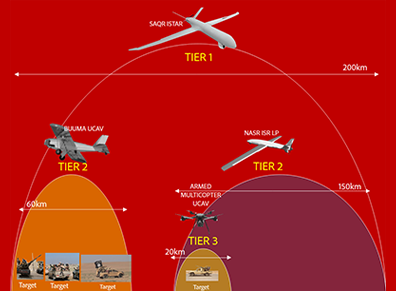The Shaheen Autonomous Collaborative System (ACS) is a multilayered architecture where
there is no dependency on any one aircraft (exclusively) to complete a mission.
The system is integrated as a mesh, interoperable, with interchangeable aircraft, with units and
payload being replaced in real time, to ensure persistent dominance and on-time, on-demand
availability of intelligence gathering, surveillance capabilities, and kinetic tools
availability.
Highlights
- The collaborative architecture enables optimal adaptation
to maintain mission performance in the face of attrition.
- This reduces risk of mission failure because one lost
aircraft can be substituted by another.
- The loss of one aircraft does not severely impact the
cost-effectiveness of the system.
- The kinetic execution can be performed with the less
expensive aircraft, when the tactical engagement is well planned.
Structural baseline
- Resilient characteristics to operate in disaggregated,
disconnected and degraded environments.
- Interconnected using a common architecture.
- Operate risk-tolerant capable aircraft to complement
survivable combat aircraft, under the same control infrastructure.
- It can, and should be implemented as a process, while
building infrastructure, training personnel, and adopting its Doctrine of Use. A well
thought integration into an already existing structure reduces the financial burden of the
acquisition.
Levels of ‘attritability’
- Tier 1 aircraft: ‘survivable’, with high
or strategic value. Their loss would significantly affect how the system will operate.
- Tier 2 aircraft: ‘attritable’,
expected to survive the mission, but damages or losses are acceptable. In numbers, Tier 2
UAV are a credible force capable of continued operations despite attrition.
- Tier 3: ‘disposable’ aircraft,
considering a life-cycle of few missions.
To gain access to restricted material with detailed
information on our ACS System, aircraft, payload alternatives, and datalink specifications,
contact us with your requirements.

